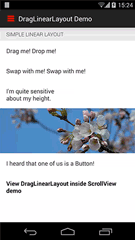DragLinearLayout
An Android LinearLayout that supports draggable and swappable child Views.
Why?
Why bother doing drag & swap in a LinearLayout when there are so many solutions for ListView?
- Simplicity - no need for
ListAdapters. By default, works like aLinearLayout. - Flexibility - supports heterogeneous, selectively draggable (or not draggable), children.
- Portability - can be used in any layout, e.g. as a child in a
ScrollViewcontainer.
Usage
Add it to your project using Gradle:
compile 'com.jmedeisis:draglinearlayout:1.1.0'The DragLinearLayout can be used in place of any LinearLayout. However, by default, children will not be draggable. To set an existing View as draggable, use DragLinearLayout#setViewDraggable(View, View), passing in the child View and a (non-null!) View that will act as the handle for dragging it (this can be the View itself).
XML layout file:
<com.jmedeisis.draglinearlayout.DragLinearLayout
xmlns:android="http://schemas.android.com/apk/res/android"
android:id="@+id/container"
android:layout_width="match_parent"
android:layout_height="match_parent" >
<TextView
android:layout_width="match_parent"
android:layout_height="wrap_content"
android:text="@string/text" />
<ImageView
android:layout_width="match_parent"
android:layout_height="120dp"
android:scaleType="centerCrop"
android:src="@drawable/image"/>
<Button
android:id="@+id/button"
android:layout_width="match_parent"
android:layout_height="wrap_content"
android:text="@string/button_text"/>
</com.jmedeisis.draglinearlayout.DragLinearLayout>Enabling drag & swap for all child views:
DragLinearLayout dragLinearLayout = (DragLinearLayout) findViewById(R.id.container);
for(int i = 0; i < dragLinearLayout.getChildCount();
i++){
View child = dragLinearLayout.getChildAt(i);
// the child will act as its own drag handle
dragLinearLayout.setViewDraggable(child, child);
}
Use #addDragView(View, View), #addDragView(View, View, int) and #removeDragView(View) to manage draggable children dynamically:
final View view = View.inflate(context, R.layout.view_layout, null);
dragLinearLayout.addDragView(view, view.findViewById(R.id.view_drag_handle));
// .. dragLinearLayout.removeDragView(view);
Attach an OnViewSwapListener with #setOnViewSwapListener(OnViewSwapListener) to detect changes to the ordering of child Views:
dragLinearLayout.setOnViewSwapListener(new DragLinearLayout.OnViewSwapListener() {
@Override
public void onSwap(View firstView, int firstPosition,
View secondView, int secondPosition) {
// update data, etc..
}
}
);
When placing the DragLinearLayout inside a ScrollView, call #setContainerScrollView(ScrollView) to enable the user to scroll while dragging a child view.
For best visual results, use children that have opaque backgrounds. Furthermore, do not use horizontal padding for the DragLinearLayout; instead, let children apply their own horizontal padding.
Refer to the included sample activity project for a demonstration of the above usage techniques and more.
Limitations
- Supports only the
LinearLayout#VERTICALorientation.
License
This project is licensed under the terms of the MIT license. You may find a copy of the license in the included LICENSE file.
